2021 Scorecard: Stefanos Tsitsipas
Rate of improvement in key areas, what still needs work, looking ahead to 2022
This is part of a new off-season series from The Racquet called ‘2021 Scorecard’. I always track a bunch of metrics for how fast some of the younger players on tour are improving in key areas and I’ll aim to post a few of these, for different players, in the next month while we get ready for the new season.
This week’s player: Stefanos Tsitsipas
Key areas of improvement: return of serve on hard courts, backhand defence on hard courts.
You can identify a few lower-priority areas where Tsitsipas can still improve. For example, he still falls substantially sideways (left) after his serve motion which can leave the line more open than it should be on occasion. But Tsitsipas’ serve (all surfaces) is usually a very strong part of his game (on both 1st and 2nd serve), and improvements here will probably be minor and incremental. It’s Tsitsipas’ return of serve on the faster courts, where he doesn’t have the time to stand deep and wind up big swings like he does on clay, and his backhand defensive ability (largely his lack of a functional slice out of that backhand corner to reset/construct points) that are the biggest issues right now.
Return Of Serve
On his beloved clay courts, Tsitsipas often has enough time to run around his backhand return to hit forehands, or has the time to hit comfortable, topspin backhand drives:
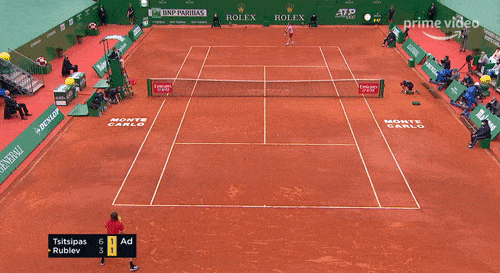
But two things often happen to Tsitsipas on hard courts.
He doesn’t have as much time to run around the backhand to find his stronger forehand.
When the server does find Tsitsipas’ backhand return, it’s much more rushed on a hard court. Tsitsipas has an extremely solid backhand, topspin drive when he has time to wind up, frankly one of the best on clay right now. But as soon as he’s forced to hit more reflexive returns he doesn’t have anywhere near the same consistency.
Tsitsipas however, to his credit, has had his best hard court return season this year by the overall numbers.
But if you look at his significant hard court losses this year…
vs Medvedev in Australian Open Semi’s
vs Zverev in Acapulco Final
vs Hurkacz in Miami Quarter’s
vs Tiafoe in Wimbledon 1st Rd (it’s grass not hard but still relevant here)
vs Opelka in Canadian Open Semi’s
vs Zverev in Cincinnati Semi’s
(there were a few more after this but his elbow injury, which he has now had surgery on, looked like an issue for some/most of them)
…while most of them are not bad losses (semi and final losses, mostly to big servers), what many of these matches had in common was Tsitsipas struggling to do enough on return when it mattered (or at all in the case of some of them).
If we get a bit more granular on Tsitsipas’ return game over the last three years, one of the problems becomes a bit more clear — his return depth depending on whether he hits a forehand and backhand.
These graphics are all for Tsitsipas’ 1st serve successful returns and they’re focusing on wide and T serves (both because Tsitsipas’ opponents only body serve him on avg about 9% of the time on 1st serve, and because it’s easy to isolate forehand and backhand on T and wide instead of body/central):
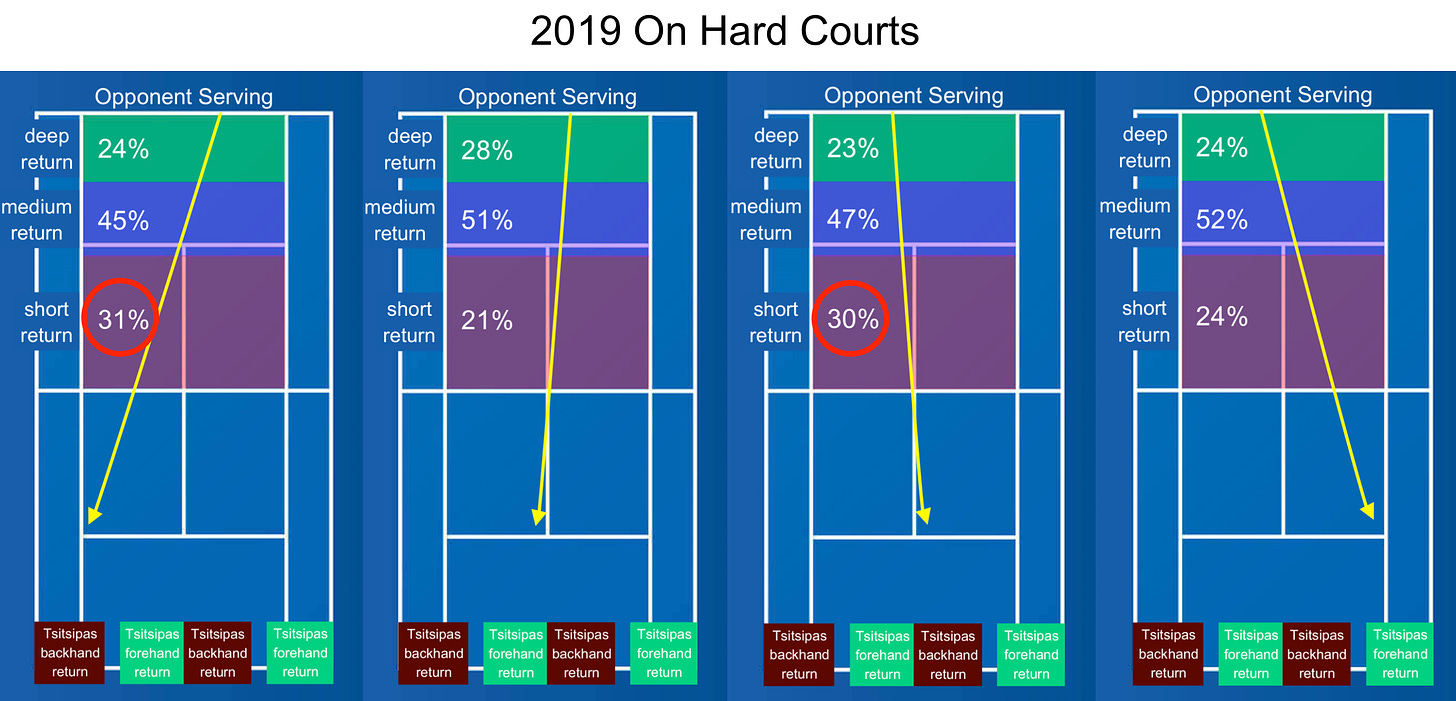

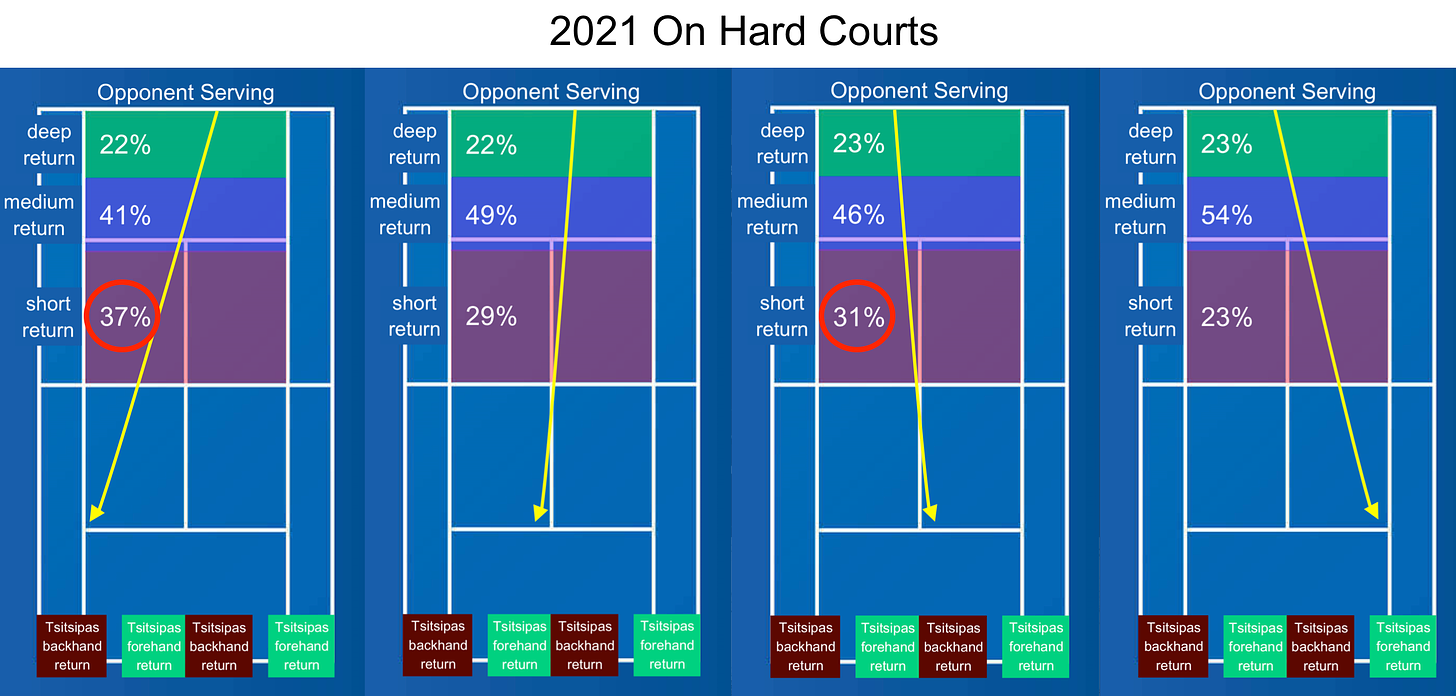
The reason the above matters comes down to a few things:
The shorter the return depth the more routine the server’s follow up shot (or ‘serve +1’) is going to be and the more likely they’ll be able to find a big, booming, point-ending forehand:
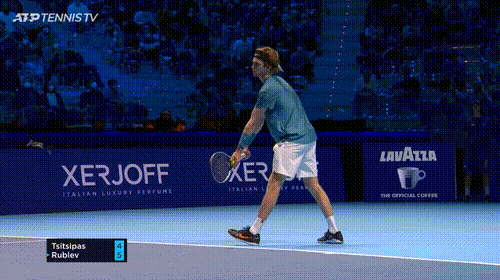
Because of that backhand return weakness, opponents rarely have to aim for risky serves close to the lines against Tsitsipas’ backhand. As long as they’re fast, they’re usually successful, which takes more pressure off the server in matchups vs Tsitsipas. Note: not all short returns are bad, they can often even be good if they force the server to net on a tough, low ball (Federer has done this well for years). But Tsitsipas’ short returns tend to sit up for put aways much more often than they provide difficult, low +1’s for the server.
Because of this wide performance difference between Tsitsipas’ forehand return depth (hitting short 1st serve returns on avg 25% of the time he puts a return in play) and his backhand return depth (hitting short returns about 34-35% of the time he puts a return in play), his opponents often have an obvious service edge in their matchup strategy with Tsitsipas. This is particularly pronounced for the AD side where Tsitsipas hits short returns off his backhand most often, which is also the side of the court where many of the most important points unfold in tennis. This also has a few second order effects like Tsitsipas occasionally over-covering his backhand side because he doesn’t want to be reaching to that side which then opens up space for the server to hit into his forehand side.
Simply put, Tsitsipas’ opponents will often be rewarded with a short, attackable ball (if it comes back at all) when they find that backhand return. And that’s exactly what they do: More than half of opponent’s 1st serves have gone into Tsitsipas’ backhand out of the three options (wide, middle, T) in the past three years.
As noted further up, Tsitsipas has found some better overall break rates and 1st and 2nd serve return points won performances in 2021 (his 2nd serve return numbers are especially encouraging at 52% return points won for hard courts this year). But his backhand 1st serve return isn’t the shot that’s responsible for that improvement, at least yet.
Part of this comes down to Tsitsipas’ backhand technique, which can be quite elaborate and can be rushed on the quicker courts…
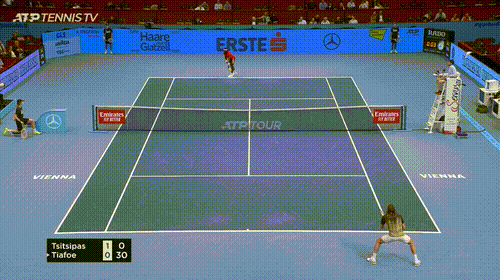
…But the other (related) part comes down to his historical unwillingness to block/slice sufficient returns of serve (especially on that backhand). Over his tour level career Tsitsipas blocks/slices returns approximately 11% of the time, some of which come from his forehand. And considering Tsitsipas’ driven, topspin backhand return has a lengthy windup, it’s interesting that the rate of improvement on that more compact, blocked return has been quite slow. There were actually some very good signs for that block return towards the tail end of his 2021 indoor season, but the elbow injury scuppered chances for Tsitsipas to play too many high level matches. I’ll keep an eye on it next year, but I’m cautiously optimistic.
This brings us conveniently on to the second area of improvement for Tsitsipas — the slice in general, and his ability to defend out of his backhand corner on hard courts.
Slice
I’ve talked about this a bunch before so I’m going to link that thread and go into some more detail:



There are two main problems with Tsitsipas’ slice. The first is his footwork to the ball. If you watch the above slow-mo comparison with Federer, Tsitsipas has clearly grown up in the tennis school of taking these huge lunging steps into contact rather than mixing in the necessary micro adjustments (a la Federer) to get his footwork sorted to hit, in this instance, a slice. What often happens when Tsitsipas is running to his backhand, trying to defend a ball, is that he makes these huge lunging steps and gets stuck open stance rather than closed stance when hitting a slice (so leading with his left rather than right leg). Biomechanically it’s extremely difficult to hit a penetrating slice in an open stance (try it yourself) partly because the dominant arm likes to swing downwards into contact past the nearby dominant leg. Federer and Dimitrov are the two best modern examples of perfect slice technique (two tweets above).
But for a few reasons it looks like Tsitsipas just never really drilled that shot when he was younger (this would explain why his topspin backhand is often so great if he almost exclusively drilled that shot and not the slice).


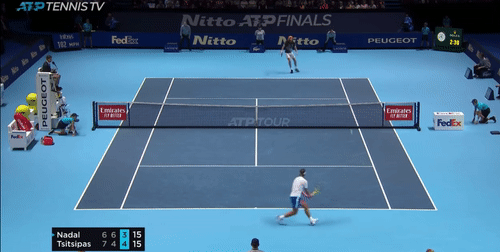
Tsitsipas doesn’t do this on every slice, but more than enough for it to be an issue.
The second problem is the actual preparation and swing of the slice itself. Even when Tsitsipas does manage to hit a closed stance slice, as Nick here rightly points out there are a couple of issues and inconsistencies with his technique (I’ll be adding to this soon). He doesn’t prepare his racquet or his body correctly and then is pretty much all right arm rather than uncoiling his upper body through contact.

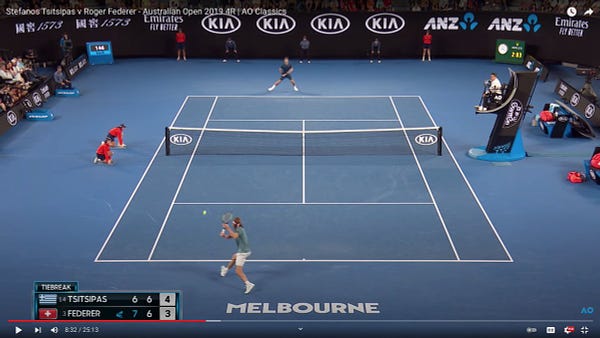
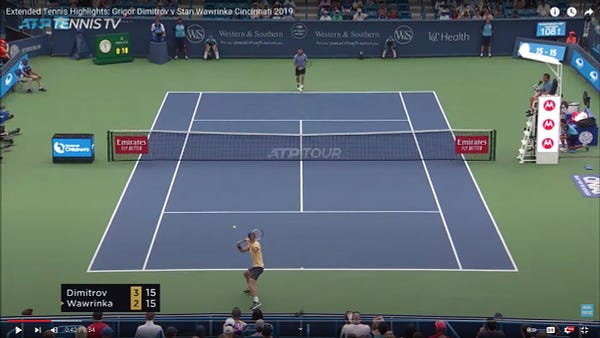
— Tsitsipas on left, Federer on right. These aren’t defensive slices, these are neutral or even offensive slices so there’s less of an issue with Tsitsipas’s lateral footwork to the ball and more of an issue with the construction of the shot and swing itself.
One of any single hander’s greatest weaknesses is their backhand defence in relation to a two hander. It’s much harder to pull off the kind of strong, open-stance backhand defence with one hand on the racquet than two (more on this here), and you see this every day in modern tennis with Djokovic, Nadal, Medvedev, Zverev et al all defending out of their backhand corner in ways which most single handers simply can’t. One could argue that this is a contributing reason as to why Tsitsipas is currently the only single hander in the ATP Top 10. The way that many single handers partly make up for this deficiency however is to have a great defensive slice. Federer, Dimitrov, Wawrinka, and increasingly Thiem before he got injured, all use that defensive slice excellently on hard courts (especially Federer and Dimitrov) to knife a ball deep into their opponents court from defensive positions to buy them time to recover back to the middle of the court for the next shot.
But for whatever reason, the slice has dropped out of fashion in recent years:
Approx slices per backhand in rallies:
Dimitrov: 46%
Federer: 37%
Thiem: 33%
Wawrinka: 31%
Tsitsipas: 20%
Shapovalov: 17%
Dimitrov arguably slices too much but Tsitsipas (and Shapovalov) arguably don’t slice anywhere near enough on the quicker surfaces. Both those younger players are guilty of offering up cheap mistakes when pushed into their backhand wing when rallies develop, or in Tsitsipas’ case he often tries to slice but ends up floating an easy attackable ball for the opponents to capitalise on.
Moving forward
These two issues, the backhand return and a lack of comfort on the slice are somewhat related. Tsitsipas clearly doesn’t have particularly good feel (relative to other elite single handers) on that slice/block motion either from static positions or even more so when running laterally onto the ball.
A year or so ago I was quite bullish on Tsitsipas’ ability to improve the slice backhand. But it doesn’t look like the Greek has progressed much with that shot in the past 1-2 years. And while the blocked return has looked better on the hard courts at times sporadically this season, it’s also let him down in some key matches. The bear case is that the shot never improves and is a fundamental roadblock in his all-court development. The bull case is to look at an example like Dominic Thiem, who was often criticised for bailing out of points on hard courts with low margin backhand drives when out of position for much of his early twenties, but then started mixing in much better slices and point construction out of his backhand corner on hard courts from around 2017 onwards. If Thiem can do it, the hope is that Tsitsipas can too.
It’s very hard to judge Tsitsipas’ 2021 season fairly, largely because he had such a brilliant first half of the year — making the semi finals at the Australian Open and then his first Slam final at Roland Garros — followed by elbow (and other) issues and a lack of form as the season progressed. The Greek’s clay ability is clearly through the roof, and he should be threatening for every, big clay court title in seasons to come. But unless Tsitsipas can start making his opponent’s lives a little more difficult after they’ve hit their serve, it’s currently tough to call him a favourite to make a title run past Medvedev, Zverev, Djokovic, Nadal (if fit) et al on hard courts (or unless a draw opens up). The funny thing about Tsitsipas is that he can find these purple patches where he’s nigh on unbreakable in his own service games, and he even occasionally finds some fleeting good return form, to combine for impressive fast-court runs (for e.g his 2019 ATP Final’s title). But unless he can bump up those returns, and preferably sort out his slice backhand footwork and swing to make that backhand less defensively leaky in rallies, both his serve and tiebreaker abilities are going to be doing a hell of a lot of heavy lifting to compensate on hard courts next year if he wants to win the biggest titles against the increasingly competent returners of Medvedev and Zverev.
Tsitsipas is already so, so good even despite these holes in his game (we’re talking about the fourth best player in the world after all). Even tiny improvements could well be the difference between winning more of the biggest hard/fast court titles, and not, in a sport with such fine margins. Hopefully Tsitsipas’ elbow heals up quick and he unveils some new tools in his hard court armoury just in time for Australia, but my hunch is that these improvements may take a while to materialise.
The very best have a habit of proving predictions like that wrong though…
2021 Scorecard for Tsitsipas
Clay season: A+
Hard Court Season: C+
Grass: N/A (one match isn’t a big enough sample)
— MW
Twitter: @mattracquet
See you on Thursday.
Top: Shelley Lipton/IconSportswire/Getty
// Looking for more?
Most recent:





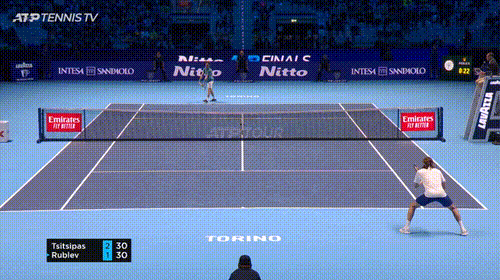
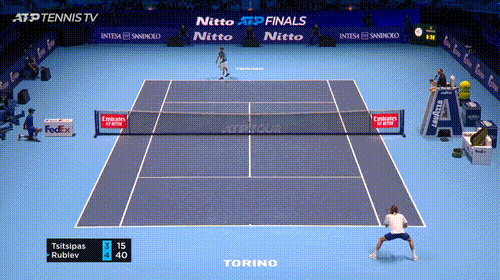
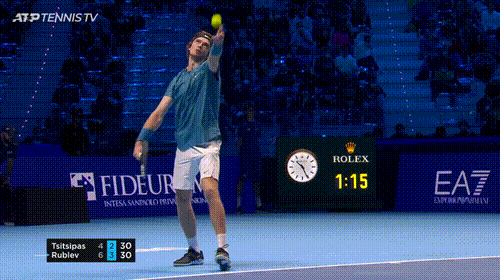
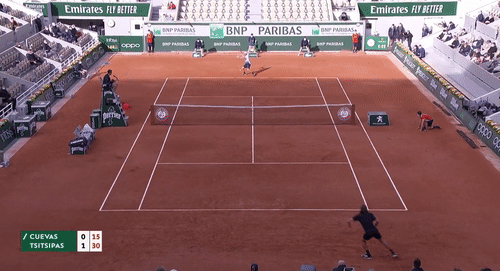

This is just great. I'll really look forward to your analyses of other players in weeks ahead!
Really enjoyed the analysis Matt (and the Scorecard concept overall).
Do you have an image of Djokovic/Schwartzmann/other strong returners’ return depth per wing to compare to Tsitsipas’ in the article? I’m very interested in seeing how elite returners perform per wing